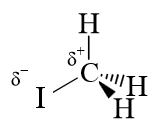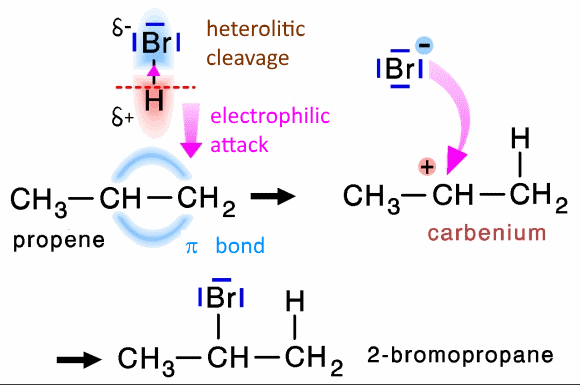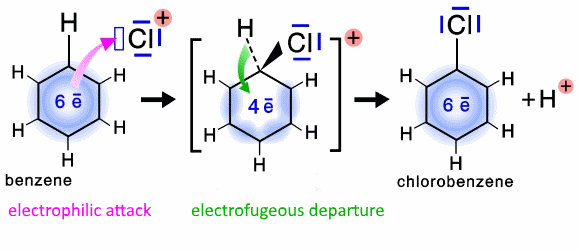







Search:

An electrophile may be a molecule or a cation which has an electron deficiency (only 6 electrons in the top layer of one of its atoms.)
A nucleophilic center is a part of a molecule or an anion which has an electron doublet which can be made avaiable to enable the electrophile to form a dative bond.
In this case, the electrophilicity (importance of electrophile character) depends on several factors:
1) Charge
Reagents that have one or more positive charges on the atom bearing the gap (empty orbital) are better than similar electrophilic reagents having only one partial positive charge or no positive charge on the atom in question.
The reason is that the positive charges attract more strongly the doublet of the nucleophilic center! In descending order of electrophilicity we find, for example:
 sulfur trioxide
sulfur trioxide
 sulfur dioxide
2) Electronegativity:
The atoms that are less electronegative are weaker electrophiles than similar atoms in the same period.
The reason is that the less electronegative atoms attract less strongly the electron pair of the nucleophilic center! By descending order of electrophilicity we find, for example:
sulfur dioxide
2) Electronegativity:
The atoms that are less electronegative are weaker electrophiles than similar atoms in the same period.
The reason is that the less electronegative atoms attract less strongly the electron pair of the nucleophilic center! By descending order of electrophilicity we find, for example:
 chloronium
chloronium
 We see that the electrophilicity decreases from right to left in a period of the periodic table: $Cl \gt Si$
3) Size of the bearer of the empty orbital:
The atoms that are smaller are more electrophilic than similar atoms in the same family.
The reason is that the smaller atoms attract more strongly the electron pair of the nucleophilic center (Coulomb's law)! In descending order of electrophilicity we find, for example:
We see that the electrophilicity decreases from right to left in a period of the periodic table: $Cl \gt Si$
3) Size of the bearer of the empty orbital:
The atoms that are smaller are more electrophilic than similar atoms in the same family.
The reason is that the smaller atoms attract more strongly the electron pair of the nucleophilic center (Coulomb's law)! In descending order of electrophilicity we find, for example:
 chloronium
chloronium
 bromonium
We see that the electrophilicity decreases from top to bottom in a family of the periodic table: $Cl \gt Br$
4) Inductive effect of atom groups attached to the bearer of the empty orbital :
Groups with I+ effect reduce the electrophilicity. Indeed, they pump the electrons to the empty orbital. These new electrons tend to push away the electron pair of the nucleophilic center! The opposite is true for groups with I- effect. In descending order of electrophilicity we find, for example:
bromonium
We see that the electrophilicity decreases from top to bottom in a family of the periodic table: $Cl \gt Br$
4) Inductive effect of atom groups attached to the bearer of the empty orbital :
Groups with I+ effect reduce the electrophilicity. Indeed, they pump the electrons to the empty orbital. These new electrons tend to push away the electron pair of the nucleophilic center! The opposite is true for groups with I- effect. In descending order of electrophilicity we find, for example:
 chloromethylium
chloromethylium
 methylium
methylium
 ethylium
ethylium
 prop-2-ylium
The methyl groups attached to the C atom carrying the empty orbital have an I+ effect and reduce electrophilicity, chlorine has an I- effect and enhances it.
prop-2-ylium
The methyl groups attached to the C atom carrying the empty orbital have an I+ effect and reduce electrophilicity, chlorine has an I- effect and enhances it.

An electrophile may be a molecule that has a permanent partial positive charge (polar molecule) or a temporary positive charge (polarizable molecule). Then it will generally abandon part of the molecule during attack.
In this case, the electrophilicity (importance of electrophile character) depends on several factors:
1) Importance of partial charge : The reagents which have a greater partial positive charge are better electrophiles.
The reason is that the positive charges attract more strongly the doublet of the nucleophilic center! In descending order of electrophilicity we find, for example:

 In the latter case, the effect of I+ of methyl decreases the partial charge on the carbon atom.
2)Stability of leaving group
The less basic the leaving group, the more stable it will be with the pair of electrons that it takes away and its departure will be more easy!
By decreasing stability: $H_2O \gt OH^-$ and $I^-\gt Br^- \gt Cl^-$
By decreasing electrophilicity, we will find for example in numerous reactions:
In the latter case, the effect of I+ of methyl decreases the partial charge on the carbon atom.
2)Stability of leaving group
The less basic the leaving group, the more stable it will be with the pair of electrons that it takes away and its departure will be more easy!
By decreasing stability: $H_2O \gt OH^-$ and $I^-\gt Br^- \gt Cl^-$
By decreasing electrophilicity, we will find for example in numerous reactions:
 iodomethane
iodomethane
 bromomethane
We see that the stability of the leaving group sometimes outweighs its electronegativity !
Note that the criteria listed above are only indications . The context of the reactions (solvent, temperature, substrate type ..) may play a decisive role.
bromomethane
We see that the stability of the leaving group sometimes outweighs its electronegativity !
Note that the criteria listed above are only indications . The context of the reactions (solvent, temperature, substrate type ..) may play a decisive role.
Some examples from the site of Athénée de Luxembourg → here
:
